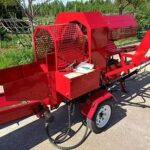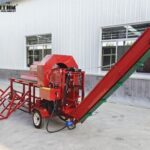Horizontal log splitter is a hydraulic or electric-powered machine that splits logs along a horizontal plane. Unlike vertical splitters, which require users to lift logs onto a vertical beam, horizontal models position the log parallel to the ground, making them easier to load and operate. This design is particularly advantageous for individuals handling large or heavy logs, as it reduces physical strain and enhances productivity.
Benefits of Using a Horizontal Log Splitter
Investing in a horizontal wood splitter offers numerous benefits, including:
Increased Efficiency: These machines significantly reduce the time and effort required to split logs, enabling users to process large quantities of firewood quickly.
Reduced Physical Strain: By automating the splitting process, horizontal log splitters minimize the risk of back injuries and fatigue associated with manual log splitting.
Enhanced Safety: The horizontal design and integrated safety features, contribute to a safer working environment.
Applications of Horizontal Wood Splitters
Horizontal log splitters find applications in diverse settings, including:
Residential Firewood Preparation: Homeowners rely on these machines to prepare firewood for heating their homes during the winter months.
Commercial Firewood Production: Firewood businesses utilize log splitters to efficiently process large volumes of logs for sale.
Landscaping and Forestry: Professionals in landscaping and forestry employ these machines for clearing brush and processing fallen trees.
Farm and Ranch Maintenance: Farmers and ranchers use wood log splitters for various tasks, including fence post preparation and woodlot management.
How Does the Log Splitter Work?
The core mechanism of a horizontal log splitter involves a hydraulic pump that drives a piston to exert force against a log, pushing it through a stationary splitting wedge. The process begins when the operator places a log onto the splitter’s rail. Activating the control lever initiates the hydraulic system, forcing the piston forward. As the log contacts the wedge, the pressure splits it into smaller pieces. Once the cycle is complete, the piston retracts, and the process repeats.



